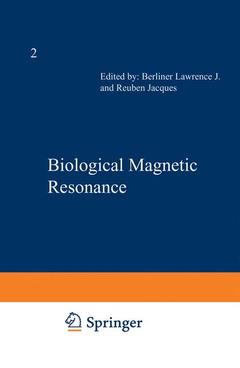Biological Magnetic Resonance, Softcover reprint of the original 1st ed. 1980 Volume 2 Biological Magnetic Resonance Series, Vol. 2
Langue : Anglais
Coordonnateur : Berliner Lawrence J.

We are pleased to present this second volume of a series that has already received much interest. The application of magnetic resonance methods to the study of actual biological systems as contrasted to cell-free samples, although not entirely novel, as demonstrated by Civan and Shporer in Volume I, has taken on new dimensions with the use of phosphorus-31 and carbon-13 NMR in studying cells, tissues, and organelles. The applications of 31 P NMR to such systems is reviewed in this volume, while carbon-13 will be covered in a later one. The use of nitroxide spin labels has grown to the point where it now may be considered a common biological technique. The synthesis and applications of a new class of nitroxides is described in this volume. ESR spectroscopy of paramagnetic ions is a powerful approach to studying molecular and structural details, as the chapter by Boas, Pilbrow, and Smith on the ESR of copper in Volume 1 has shown. In this volume the ESR of molybdenum and iron is treated in a comparable fashion. In the first volume some aspects of 1 H NMR spectroscopy of certain classes of In this volume the high-resolu biological macromolecules were discussed.· tion multinuclear NMR spectra of peptides, including the physiologically significant peptide hormones, are reviewed.
1 Phosphorus NMR of Cells, Tissues, and Organelles.- 1. Introduction.- 2. Methods.- 3. Applications.- 4. Summary.- References.- 2 EPR of Molybdenum-Containing Enzymes.- 1. Introduction.- 2. Enzymes to be Considered and Their General Properties.- 3. Relationship of Molybdenum to Other Constituents in the Enzymes and its Interactions with These Constituents.- 4. Multiple Species of Mo(V) and the Estimation of EPR Parameters.- 5. General Survey of the EPR Parameters of Mo(V) Species in Enzymes.- 6. Discussion of the Parameters.- 7. Conditions Governing Generation and Interconversion of the Signals.- 8. Conclusions on Structures and Enzymatic Mechanisms.- References.- 3 ESR of Iron Proteins.- 1. Introduction.- 2. Electron Spin Resonance Caused by Iron Proteins.- 3. Heme Proteins.- 4. Nonheme Proteins.- References.- 4 Stable Imidazoline Nitroxides.- 1. Introduction.- 2. Synthesis of Imidazoline and Imidazolidine Nitroxides.- 3. Properties of Imidazoline Nitroxides and 1 -Hydroxy-3-imidazolines.- 4. Spectra of Imidazoline Nitroxides.- 5. Magnetic Properties of Imidazoline Nitroxides.- 6. Applications in Analytical and Structural Chemistry.- 7. Imidazoline Spin Labels in Biology.- 8. Syntheses of Some Imidazoline Nitroxides and Important Intermediates.- References.- 5 The Multinuclear NMR Approach to Peptides: Structures, Conformations, and Dynamics.- 1. A Multinuclear Approach.- 2. Chemical Shifts.- 3. Spin-Spin Coupling Constants.- 4. Relaxation Times.- 5. Concluding Remarks.- References.
Date de parution : 11-2012
Ouvrage de 351 p.
15.2x22.9 cm
Thèmes de Biological Magnetic Resonance :
Mots-clés :
NMR; Nucleotide; Oxidation; alcohol; biology; carboxylic acid; chemistry; enzymes; ferritin; kidney; magnetic resonance; metals; protein; structure; synthesis
© 2024 LAVOISIER S.A.S.



